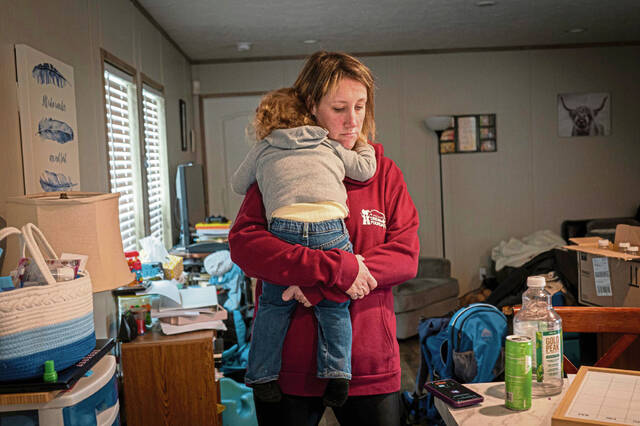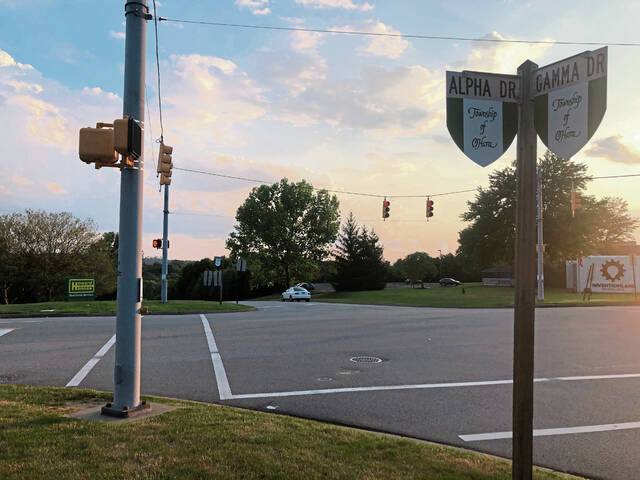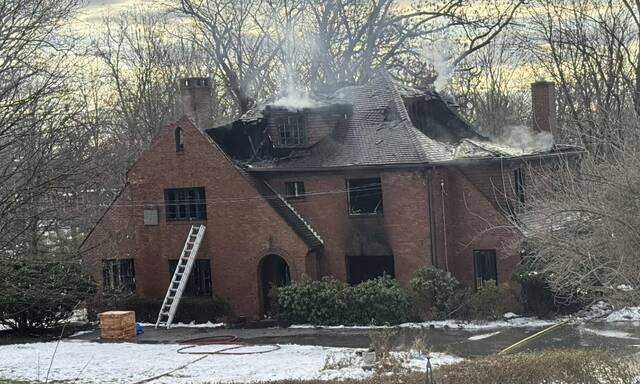Until a few weeks ago, some Vandergrift No. 1 volunteer firefighters would answer rescue calls in one-piece cotton jumpsuits ripped from decades of crawling into mangled vehicles and performing hillside rope rescues.
The rescue gear wasn’t specially rated for safety — or especially well-fitting, according to Chief Randy Dunmire.
“Just a plain, heavy-duty work jumpsuit,” he said.
State Farm recently supplied a $10,000 grant that let the department swap out the last of the aging red jumpsuits, but the department’s wish list is long — much too long to be filled by a small award from an insurance company.
New portable radios are needed, a request turned down by the Federal Emergency Management Agency (FEMA) five years running, though it did provide $62,000 last year for hoses, nozzles and similar equipment.
With the help of a grant writer, the department is trying a joint bid for radios with two neighboring departments: Vandergrift No. 2 and North Apollo Station 170.
“Grants are an important part of most fire departments in this Valley,” Dunmire said. “Money is tight in our communities.”
Such is life for some volunteer fire departments in Western Pennsylvania: Rundown equipment, disparate funding sources and the hope that this year will be the one where money for new radios, turnout gear — even trucks — comes through.
Federal grants, a multimillion-dollar difference maker in some cases, can be difficult to harness.
During the application window for fiscal year 2024, FEMA received nearly $4 billion in requests for its three major grant programs. It only has $292 million to give out, and no special consideration is given to repeat applicants, a FEMA spokesperson said.
“Say a department is lucky enough to get a grant … but then, the next year, they’re not so lucky. Maybe for 10 years they’re not that lucky” said Sarah Lee, CEO of the National Volunteer Fire Council, a nonprofit that represents the interests of volunteer fire departments, EMS and rescue services on the national level.
“You can’t count on that being part of your budget.”
The Pennsylvania Fire Commissioner’s office did not return TribLive requests for grant data, but people familiar with its Fire and Emergency Medical Services grant program described those awards as easy to obtain.
“It’s not really competitive,” said David Schwartz, founder and president of Firehouse Grants, a grant writing service for emergency responders. “It’s an exercise in completing the application correctly and on time.”
The catch: Grants are capped at $20,000 per fire department and $15,000 per ambulance service. That’s because the program receives $30 million a year to distribute to applicants, including many of the state’s 1,800 fire departments.
Urged on by Gov. Josh Shapiro, some lawmakers have tried to double that to $60 million while refining the rules on eligible uses and funding prioritization.
State Rep. Jared Solomon, D-Philadelphia, chairs the state House Veterans Affairs and Emergency Preparedness Committee. He said efforts in the last budget cycle to boost and streamline funding “just ran out of time.”
Instead, lawmakers reauthorized the program through 2029, preserving a low-hanging lifeline for volunteers without any boost in funding.
He didn’t rule out another reform attempt for the 2025-26 budget.
“There was a lot of willingness on both sides of the aisle to support some form of the proposal,” Solomon said.
He added, however, “there were some disagreements in terms of changing the more expansive vision of the work we wanted those dollars to do.”
State Sen. Doug Mastriano, R-Franklin, who chairs the committee’s Senate counterpart, did not return requests for comment.
Chafing against the limits of this dedicated funding stream, some stations have instead pursued money through the state’s Gaming Economic Development Tourism Fund and the gambling-funded Local Share Account, according to State Rep. Joe McAndrew, D-Penn Hills. That path, though, involves competition with municipalities, authorities and other equally desperate organizations.
“You might get a win here and there from the feds, but realistically… there’s not a ton of avenues for these guys to get funding,” McAndrew said.
Pressure from all sides
Even those fortunate few departments that land substantial grants have their work cut out for them.
David Silvis, chief of the Export Volunteer Fire Department, rejoiced when a $545,000 federal grant arrived in 2023, but work to fund a new, nearly $1 million fire engine had only begun. About a year and a half later, fundraising through fish fries, the borough’s ethnic day and other events have almost made up the difference.
These events, he said, are “how we’re still here and how we’re still operating.”
It’s getting harder, though, for fire departments to pull off pancake breakfasts and spaghetti dinners for the same reason they’re struggling to handle grant writing: dwindling ranks.
Since the 1970s, the ranks of Pennsylvania’s volunteer firefighters have dipped from 360,000 to fewer than 37,000, per the U.S. Fire Administration. That’s a 90% reduction in people available to go on calls and also to handle the day-to-day administrative tasks.
“This is basically a full-time, unpaid job,” Silvis said, stepping away from his day job for a couple of minutes. “We’re constantly looking for any opportunity for funding, but it’s a struggle, because volunteers are really in decline.”
FEMA award recipients are determined in equal measure by a computer-assigned score and a score given by a panel of fire officials.
Larger departments don’t necessarily have an advantage when seeking federal dollars, since there are separate tranches based on call volume and service area.
That means consolidation, a once-fringe option that could soon be necessary for many cash-strapped stations, won’t help score funding, even while it offers other financial advantages.
One-off cooperation
Joining with neighboring stations on a one-time basis, though, is a sound strategy for departments struggling to land grants, according to Schwartz, head of Firehouse Grants.
And, even without some kind of formal arrangement, Dunmire, the Vandergrift No.1 chief, can attest to the value of constant contact with peers.
“Fire companies talk,” he said. “I’ll be talking to a fire chief somewhere, and they’ll say, ‘Did you hear about this grant from so-and-so?’”
Just registering for the federal award management system can take several hours, Lee estimated, and applications can take 20 hours, 30 hours — even a workweek’s worth of effort.
From there, “you got to have data, you got to have statistics, you got to be able to make a case,” she explained about the grant writing process.
That’s where people like Schwartz can come in — for a price. Roughly speaking, he assists with 150 to 200 applications a year at a rate of $1,000 to $5,000 per application. Other grant writers, like the one hired by Vandergrift No. 1, also take a small cut of earned awards.
The key, according to Schwartz, is understanding the program guidelines.
“You have to start by identifying your department’s needs and matching them up with the program’s priorities,” he said. “If you miss that step, you can come up with the best narrative a person can write, but it’s never going to get funded, because you’ll never make it past the computer algorithm score that’s taking in the priority of the project.”








